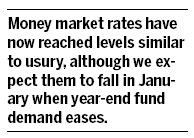Business
Benchmark money market rate jumps 22 basis points
By Lu Jianxin and Jason Subler (China Daily)
Updated: 2010-12-31 08:14
 |
Large Medium Small |

SHANGHAI - China's benchmark money market rate jumped 22 basis points to more than 6.25 percent on Thursday, its highest level in three years, after the central bank raised interest rates on the loans that it makes to commercial banks.
The People's Bank of China (PBOC) announced the increases in the rediscount and relending rates on Wednesday, the first such change in two years.
It is a move that dovetails with its October and December benchmark interest rate rises and signals it is not letting up in its recent tightening campaign.
As banks rarely tap the PBOC for funding, partly because that would make them appear financially unhealthy, the impact of the rate rises will be limited.
But with funding costs in the money market having surged recently, the PBOC's move to raise costs for banks to borrow from it sent a signal that it would not consider relaxing its tightening stance regardless of what happens in the market, traders said.
"Money market rates have now reached levels similar to usury, although we expect them to fall in January when year-end fund demand eases," said a dealer at a bank in Shanghai.
"This is something no one in the market had ever expected until the last two or three weeks. More surprises are possible as many institutions are now so alarmed that they may tend to hoard more money in the future."
On Thursday, the weighted average seven-day government bond repurchase rate, the main barometer of short-term liquidity in the money market, rose to 6.3411 percent at midday from 6.1190 percent at the close on Wednesday.
The shortest one-day bond repo rate surged 37 bps to 5.1042 percent and the 14-day rate rose 20 bps to 6.5391 percent.
Market liquidity has reached unprecedented tight conditions as chronic factors, such as banks needing money at the end of the year to help meet the loan-to-deposit ratio and other regulatory requirements, are coupled with fears of more tightening steps.
The PBOC has raised official rates twice since mid-October, both at times when they were not expected, and it has also raised bank reserve ratios three times since mid-November.
More importantly, there is no correlation between market rates and banks' benchmark interest rates that could help neutralize the acute liquidity shortfall.
China's official interest rates are set by the government, with deposit rates allowed to be set slightly lower than the PBOC-fixed benchmarks, while lending rates may be slightly higher. The official one-year lending rate now stands at 5.81 percent, much lower than the seven-day repo rate.
The government has promised to reform its rigid interest rate system but the long-awaited reforms have not come so far, partly because Beijing feels obliged to protect the interests of depositors in a populous country with a very high savings ratio so as to guard social stability.
But the latest developments in the money market may nudge the government in that direction, traders said.
In a sign that the reforms may be on the agenda now, a senior PBOC official on Wednesday called for the country to hasten the liberalization of its interest rate system to rein in accelerating inflation in the world's second- largest economy.
Reuters